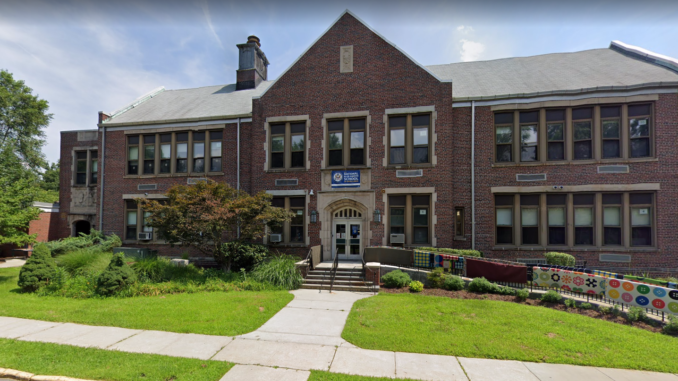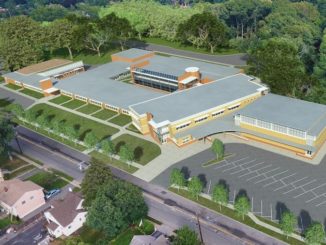
WESTWOOD, N.J.—Property owners along Berkeley Avenue between Harrington Avenue and Lowell Street are mobilizing in advance of the Aug. 20 council meeting to make their best case for restoring two-way traffic.
They argued at the July 16 council meeting that part of a Berkeley Elementary School-area traffic flow overhaul enacted by resolution, which made Berkeley Avenue one-way at all hours year-round, was foisted on them and is dangerous and inconvenient.
They wanted the rule not to be introduced as a borough ordinance, or failing that, that it not be approved.
The council, aiming to have a safe, legal, and workable solution in place by the start of the school year, introduced the plan all the same.
It had scheduled the measure’s second required vote for an Aug. 6 special meeting but pushed it back to Aug. 20 at 8 p.m. after several affected residents said they only had just learned about it.
Anyone with input on the ordinance but can’t attend the meeting can write the mayor and council via the Borough Clerk, referencing Ordinance 19-11, which is on the borough website.
Crossing guard felled in 2015
The need for traffic improvements in the area has been clear to local residents for years.
In October 2015, Westwood crossing guard Cyril Kearney was struck by a car while on duty as he was helping a woman cross the intersection outside Berkeley Elementary School.
After surgeries, complications, and therapies, it took almost a year before he fully recovered and became independent.
Residents said they weren’t heard
Resident Maryellen Yale of Lowell Street asserted her outreach—including a petition signed by 22 households on Lowell Street and Berkeley Avenue, and one on Lexington Avenue—seemed to have disappeared “into a black hole,” and suggested police failed to connect with all residents.
She also was critical of the Westwood Regional School District, which she said had not yet shown itself as a good neighbor in solving the problem.
Yale, one of approximately a dozen residents who spoke at the public comment portion of the July 16 council meeting, complained of the sudden appearance Nov. 5, 2018, of one-way/do not enter signs at the intersection of Lexington Avenue and Lowell Street.
They said drivers no longer are allowed to enter Lowell Street and Berkeley Avenue from Lexington Avenue.
The residents asked that Lowell Street and Berkeley Avenue revert to two-way traffic streets and that Berkeley School, the school board, and the Police Department partner with area residents on a solution that would “stop letting the handful of Berkeley School parents who refuse to follow the rules and cause the havoc on our streets dictate a bad solution to all of us.”
Yale said, “We are the ones most affected by this change and yet we are the ones left out of most of the communications.”
Her husband, Mark, said he could no longer safely back out of his own driveway and predicted he would be hit or that one of his kids would be injured.
He threatened, in that eventuality, to sue the borough.
“Our driveway is two houses away from Lexington. We are vulnerable because this change has increased the speed on our section of the street. People come around the corner and they’re doing 35 [miles per hour] plus. You hear them accelerate around the corner going through the stop sign every single time,” he said.
Compromise worked, residents say
Before the change, temporary barricades were placed at the intersection of Harrington and Berkeley avenues during the half hour drop-off and pick-up times each day, and this had pros and cons but was seen as a good compromise.
Yale told the council that residents were told that the one-way change was for a 90-day trial period.
“When the 90 days were up we contacted the Police Department and were told that all of us had misunderstood: it was 90 school days, not 90 days, something that had not been clearly communicated to us in the beginning,” she said.
She added, “We thought the situation was finally coming to an end and we would have a chance to express our dissatisfaction, but instead we were forced to endure the changes for another month and a half.”
Council President Ray Arroyo, speaking to the lack of enforcement during the test period, said “The Police Department was half in and half out on this because there wasn’t an ordinance. There was a resolution.”
He added, “The test period went longer than it should have. We recognize that the Police Department needs to have a more assertive role in what happens down there.”
Chief says changes proved positive
Reached for comment on this story July 17, Police Chief Michael Pontillo defended his department’s outreach and said changes tested out had improved safety.
He detailed what read as frustration with the Westwood Regional School District.
“The school refused to assist with the drop off, indicating that their employment contracts do not allow them to engage in such behavior. We asked the school to do more to assist in reducing the complaints in the area,” he said.
He added, “We asked for split drop off times and were told no. We asked for bussing and were told no. We asked for teacher parking on the Berkeley property and were told no—which then turned to a yes, in time.”
Pontillo said, “The school stopped outside drop-off in conjunction with the start of the new traffic pattern. This resulted in more parents dropping off, not parking along Harrington Avenue and walking their kids onto the blacktop.”
He said a parent brought this up at the community meeting but parents “were not told why this happened. The school district was invited to that meeting but did not attend.”
Pontillo said Lt. Richard Antonacci went door to door in the neighborhood with information packets as the traffic flow overhaul was taking shape, and noted feedback.
He said, “We missed some who didn’t answer the door.”
Of those residents who were available, he said, each received a packet from the police department “that was left for all residents.”
He said Antonacci’s outreach recorded “only two objections from all the residents that were spoken to.”
The final product incorporates that feedback along with modifications reached after a test period and in meetings with the school district and in review of suggested statutory allowances, Pontillo said.
“We have added marked delineators at the intersection of Lexington and Lowell, where the one-way exits, in an effort to prevent wrong-way traffic. There have been no wrong-way accidents from the start of the test period to the time of this writing,” Pontillo said.
Asked his sense of the overall benefit of the plan, including the contested one-way changes, Pontillo wrote:
“The new pattern has resulted in a safer and more orderly drop-off and pickup from Berkeley School. This has reduced traffic congestion on Berkeley Avenue and the surrounding streets and has expedited the clearing out of vehicular traffic around the school.”
He added, “This results in a better and safer daily driving experience in the area. The evening benefit to the affected residents is that the street is no longer a cut-through for evening rush-hour traffic passing through Kinderkamack’s corridor to River Vale and beyond.”
According to Pontillo, “The infrastructure can handle only so many cars so fast.”
He said the test period was done under resolution, which the police department cannot legally enforce.
“Once the ordinance is in place there will be strict enforcement of the ordinance and traffic law requirements in the area to address resident concerns,” he said.
‘We didn’t ask for one-ways’
Superintendent of School Raymond Gonzalez told Pascack Press, “Westwood Regional School District has no jurisdiction over the streets surrounding its schools. Neither the school, the district, nor the Board of Education requested a change in the traffic pattern to make Berkeley Avenue a one-way street.”
He said that on being notified that a change was pending the district “provided feedback to our law enforcement and municipal partners in two meetings regarding the challenges and opportunities of their plans.”
Further, he said, “We also passed along communication to the school community from the police department regarding their changes to the traffic pattern.”
Gonzalez said, “School personnel do not have the authority to enforce parking or direct traffic. Only law enforcement officials have the authority to enforce the laws. The school communicates with their families to remind them of their responsibilities for a safe drop off and pick up.”
According to Gonzalez, “Once students arrive and exit their vehicles, staff direct them into the building.”
He also described “a cooperative working relationship” with the borough, saying that over the past two years the borough, elementary and middle schools were recognized as Gold Level NJ Safe Routes to School program winners for work promoting pedestrian and bicycle safety.
‘We hear you’
At the July 16 council meeting, Mayor John Birkner Jr. said that the borough could not compel the school board to answer residents’ concerns.
Birkner and councilmembers took up Maryellen Yale’s communication complaint specifically.
Councilman Chris Montana said, “There’s a disconnect here that doesn’t make sense to me and it doesn’t sit well with me. The ability for our residents to feel heard and believe they are heard is important. No one up here does not want to hear you, so know that.”
Of the traffic flow around school pickups and drop-offs, he added, “I think this is the responsibility of the school. They have been totally lax and negligent in addressing the situation.”
Council president dug deeper, sent memo
Arroyo, speaking for himself and Councilwoman Erin Collins, noted that they had been in touch with Pontillo and Borough Engineer Gary Ascolese, of Boswell Engineering and formerly with the Bergen County Engineering Department, on residents’ concerns within a complex plan affecting “overlapping constituencies affected in different ways.”
They said in the memo, a copy of which Pascack Press obtained from the borough, “The challenge for the governing body will be to weigh the benefits of the recommended change against any perceived detriments and make a decision that is in the best interests of the borough and for the greater good of the people we serve.”
The memo—sent as the school year and traffic pattern overhaul test period were drawing to a close—shows Arroyo and Collins working to address the petitioners’ concerns.
“These residents have offered several rationales for their request—the most compelling of which may be the disparity of creating a permanent, year-round inconvenience—Harrington now only accessible via Lowell to Roosevelt to Harrington—for such a small duration of utilization, and only during the school year,” they said.
The memo continues, “The question of whether the one-way presents a public safety detriment (emergency service response time diminished by one-way access to Berkeley Avenue) has also been raised. And that concern needs to be analyzed and answered.”
The councilmembers said that when Ascolese inquired with the state Department of Transportation as to whether the two-way might be maintained and the one way made temporary, the engineer relayed the response he’d gotten from a NJDOT traffic regulations investigator.
He cited a statutory section that speaks to a maximum duration of three months to address an “emergent” situation that is a bonafide “temporary condition.”
In Ascolese’s view, the borough was barred from the traffic plan reverting back to a two-way flow after pick up and drop off.
The councilmembers connected with a supervising engineer at NJDOT Bureau of Traffic Engineering and forwarded Pontillo and Ascolese notes on lawful alternatives, which Arroyo said involved “ugly” logistics.
“We see it as our due diligence in exploring and mitigating the objections that property owners have raised against a permanent one way,” Arroyo and Collins wrote.
Other changes…
Other changes detailed in Ordinance 19-11 set out:
- All-day parking prohibitions on Berkeley Avenue west and Harrington Avenue north and south;
- Restricted parking on school days on Berkeley Avenue east and west and Harrington Avenue south;
- A school employee parking zone on Westvale Park west and Sand Road east.
- School crossings are designated at Third Avenue and Pine Street, Third Avenue and Mill Street, Mill Street and Clairmont Avenue, Clairmont Avenue and Westend, Lake Drive and Forest Avenue, Ridgewood Avenue and Lafayette Avenue, Elm Street and First Avenue, Kinderkamack Road and Westwood Avenue, Harrington Avenue and Berkeley Avenue, and Sand Road and Pascack Road.



